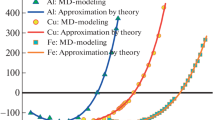Abstract
The molecular dynamics (MD) method seems to be the most promising method for determining the lattice contribution to the overall thermal conductivity of metals and metal alloys. In this study, the MD method with a proven potential is used for studying the lattice thermal conductivity of aluminum at high and low temperatures. It is shown that standard algorithms are more convenient for calculating the lattice thermal conductivity coefficient at high temperatures. In this case, the thermal conductivity coefficient is calculated using the Fourier equation, and the MD calculations are used to simulate a steady nonequilibrium state with a linear temperature gradient at a length comparable to the size of the calculated cell. This approach gives the values of the lattice thermal conductivity coefficient, which are in good agreement with the results of the first principles calculations. The thermal conductivity coefficient decreases with a decrease in the size of the base crystallite because of the depletion of the low frequency section of the phonon spectrum, the contribution of which to thermal conductivity becomes insignificant with an increase in the temperature. At high temperatures, the thermal conductivity coefficient does not depend on the crystallite size and agrees with the value obtained from the first principles calculations. To calculate the thermal conductivity at low temperatures, a new method based on the homogeneous heat equation for an infinite line is proposed. In this case, the MD method is used to obtain a steady state nonequilibrium temperature distribution in the system in the form of a Gaussian curve that corresponds to the fundamental solution of the equation. The approximation of system relaxation from the nonequilibrium state to the equilibrium one makes it possible to determine the thermal diffusivity coefficient related to the thermal conductivity coefficient. The test calculations performed for a thin aluminum film at low temperatures with different initial conditions show that the obtained thermal diffusivity coefficient does not depend on the parameters of the initial Gaussian distribution, which suggests the applicability of the proposed method for studying the lattice thermal conductivity.








Similar content being viewed by others
REFERENCES
P. Bhalla, P. Kumar, N. Das, and N. Singh, Phys. Rev. B 94, 115114 (2016). https://doi.org/10.1103/PhysRevB.94.115114
F. Müller-Plathe, J. Chem. Phys. 106, 6082 (1997). https://doi.org/10.1063/1.473271
D. J. Evans and W. G. Hoover, Ann. Rev. Fluid Mech. 18, 243 (1986). https://doi.org/10.1146/annurev.fl.18.010186.001331
S. Plimpton, J. Comput. Phys. 117, 1 (1995). https://doi.org/10.1006/JCPH.1995.1039
R. R. Zope and Y. Mishin, Phys. Rev. B 68, 024102 (2003). https://doi.org/10.1103/PhysRevB.68.024102
E. B. Dolgusheva and V. Y. Trubitsin, Phys. Solid State 60, 837 (2018). https://doi.org/10.1134/S1063783418050074
E. B. Dolgusheva, Comput. Mater. Sci. 155, 55 (2018). https://doi.org/10.1016/j.commatsci.2018.08.033
P. Wirnsberger, D. Frenkel, and C. Dellago, J. Chem. Phys. 143, 124104 (2015). https://doi.org/10.1063/1.4931597
E. I. Salamatov and E. B. Dolgusheva, Khim. Fiz. Mezosk. 22, 281 (2020). https://doi.org/10.15350/17270529.2020.3.27
E. I. Salamatov and E. B. Dolgusheva, Phys. Status Solidi B 258, 2000484 (2021). https://doi.org/10.1002/pssb.202000484
Y. Wang, Z. Lu, and X. Ruan, J. Appl. Phys. 119, 225109 (2016). https://doi.org/10.1063/1.4953366
A. Jain and A. J. H. McGaughey, Phys. Rev. B 93, 081206(R) (2016). https://doi.org/10.1103/PhysRevB.93.081206
A. N. Tikhonov and A. A. Samarskii, Equations of Mathematical Physics (Nauka, Moscow, 1977; Dover, New York, 2011).
V. E. Zinov’ev, Thermophysical Properties of Metals at High Temperatures, The Handbook (Metallurgiya, Moscow, 1989) [in Russian].
Funding
This study was performed using the Uranium cluster of the Supercomputer Calculation Center at the Institute of Mechanics and Mathematics, Ural Branch, Russian Academy of Sciences, within research topic no. 121030100005-1 Theoretical Studies of Phase States, and Spectral and Kinetic Properties of Electrons and Phonons in Systems with Reduced Dimensionality of the Udmurt Federal Research Center, Ural Branch, Russian Academy of Sciences.
Author information
Authors and Affiliations
Corresponding author
Ethics declarations
The authors declare that they have no conflicts of interest.
Additional information
Translated by O. Kadkin
Rights and permissions
About this article
Cite this article
Salamatov, E.I., Dolgusheva, E.B. Methods for Calculating the Lattice Thermal Conductivity of Metals at High and Low Temperatures. Phys. Solid State 64, 460–466 (2022). https://doi.org/10.1134/S1063783422090074
Received:
Revised:
Accepted:
Published:
Issue Date:
DOI: https://doi.org/10.1134/S1063783422090074




